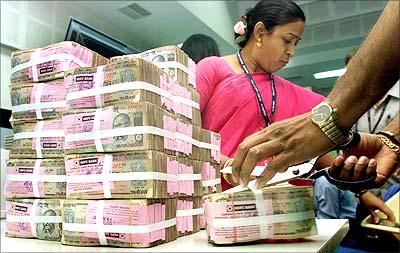F P S Murlidharan Jan 23, 2014
The Reserve Bank of India vide Press Release dated 22 January, 2014 advised that currency notes issued prior to 2005 would be withdrawn. From 1 April, 2014 public are advised to go to any bank whether they have account with it or not and get notes issued in 2005 or thereafter in exchange.
No questions or proof would be asked till 30 June 2014 when one approaches the banks for such exchange. However from 1 July 2014, one has to give proof of identity and address should he require more than ten pieces of pre-2005 Rs 500 or Rs 1,000 notes to be exchanged.
Representational image. AFP
The RBI has advised people not to panic at this action and that the pre-2005 notes can be easily identified because they simply do not bear the year of minting on their backs whereas notes issued in 2005 or thereafter bear the year on their backs.
The RBI is silent on many issues. What is the intention underpinning this move? Surely no demonetisation is on cards because even from 1 July, 2014 one can avoid the inconvenience of having to give proofs of identity and residence if he is prepared to go to as many bank branches as warranted.
To wit, suppose he has 20,000 Rs 500 notes, all that he has to do is to go to 2,000 different branches of banks in India and surrendering at each bank exactly ten notes for exchange. He can even allocate this disagreeable work among his family members and friends whom he trusts. In the event, one is at a loss to understand what exactly is sought to be achieved by this potentially disruptive move.
One can visualise the scene easily. Come 1 April, 2014 there would be serpentine queues at the cash counters of bank branches. The cashiers would have to look with magnifying glasses at each note surrendered given the fact that the year is printed in smallest font possible. More aggrieved by the move would be the common folks especially senior citizens whose eyesight is not so good.
The RBI has said that the old notes ie those issued prior to 2005 would be legal tender. For how long? Well, this aspect has been kept open-ended. Let us say the deadline is in due course set as 31 December, 2014 which would mean from 1 January, 2015, pre-2005 currency would no longer be legal tender. Now the entire economy would be in turmoil.
People hitherto have been counting notes given to them in a banking or trade transaction besides of course displaying their knowledge real or pretended of telling between a fake and real currency. They would now have to do another thing — see if the notes given to them are post 2004 and for this purpose those endowed with poor eyesight may have to carry a magnifying glass in their pockets at all times. Each note has to be carefully checked. Those with poor eyesight would feel this extremely challenging and inconvenient.
One can say by the deadline date more than say 95% of old currency notes would have been surrendered to the banking system but there is an outside chance that some of the notes no longer legal tender are still in circulation. People don’t like to take chances. They would not be reassured by the official position that all old currencies have been flushed out.
The RBI’s disruptive move begs the most important question — why this anarchic financial move when so much leeway has been given to the black moneyed people? One could have understood had no wiggle room whatsoever had been given. But exception given upto 10 high denomination notes of 500 and 1,000 is bound to be lapped up with alacrity. The leg work involved in going to more than one branch would hardly deter them when it has not deterred them for avoiding TDS. Bank branches are required to deduct tax at source on interest from term deposits only if the interest from a branch exceeds Rs 10,000 during a financial year.
Let Baba Ramdev not exult and open the bubbly err... the amla bottle because the quasi demonetisation scheme, as it were, warts and all, does not target only high denomination notes namely 500 and 1000 but currency notes of all denominations including 5, 10, 20, 50 and 100, unless the Finance Ministry and RBI are working on a secret plan of demonetisation and would give in exchange denominations other than 500 or 1,000, come 1 April, 2014. Should that happen the RBI would have on the all fools day pulled off the most brilliant if cunning plan ever which of course would be marred by the leeway discussed above —exchange of high denomination notes upto 10 at any branch without any questions being asked.
If this is what the plan is, it should forthwith close the loophole and say even one note has to be explained for, come 1 July 2014. Black moneyed people may also hit upon another counterblast — start accumulating small denominations notes right away. Who knows in the run up to 1 April, 2014 the country might witness shortage of small denomination notes. They may even be bought at a premium.

